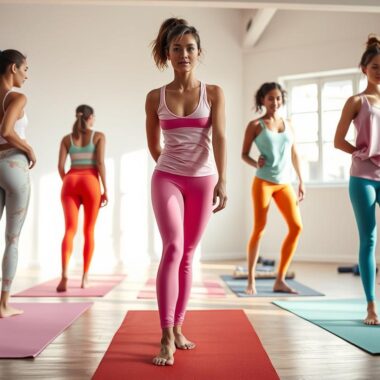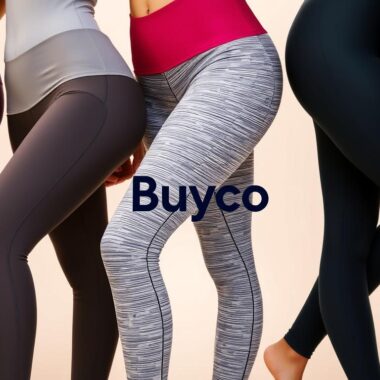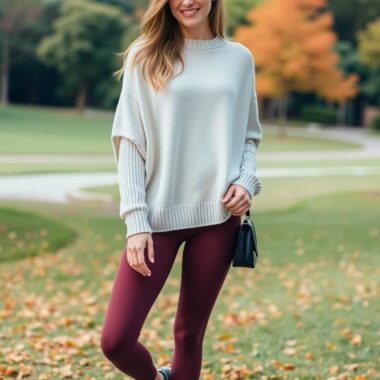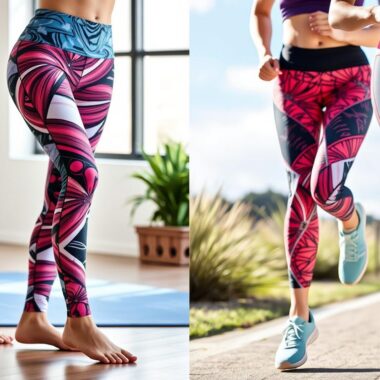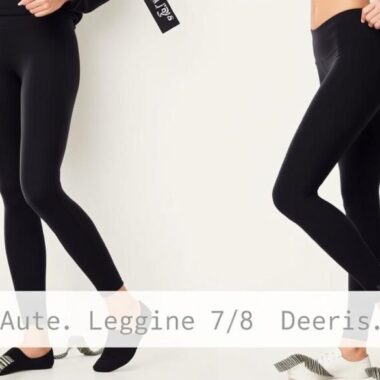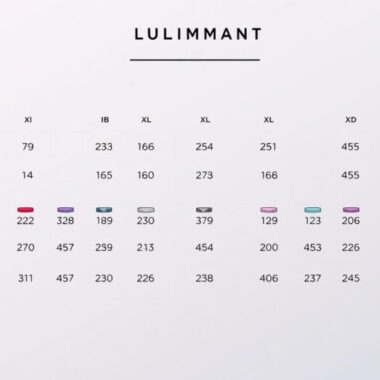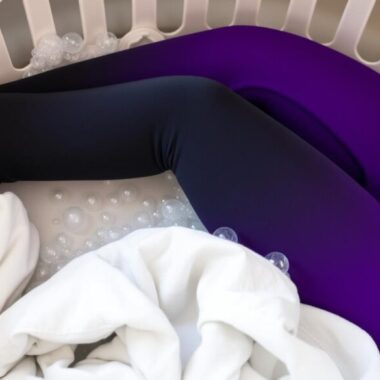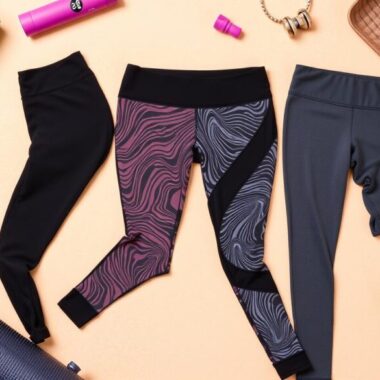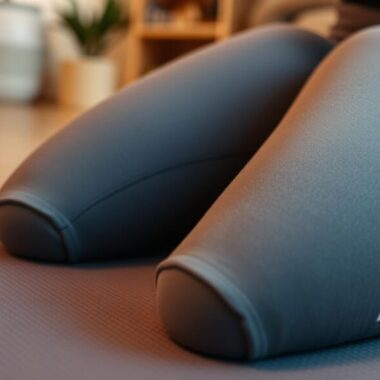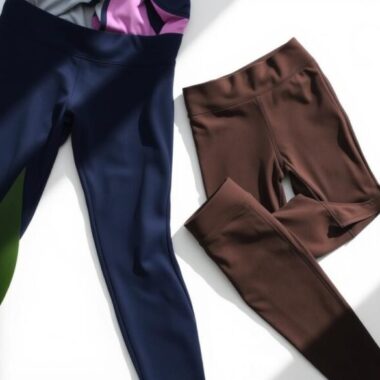I love yoga and wearing athleisure clothes. People often ask me about my Yoga Leggings Fabric. It’s a good question because the material affects how comfy, how well they perform, and how long they last.
In the world of what is yoga leggings fabric called, yoga pants material, stretchy fitness fabrics, athleisure clothing materials, and performance apparel textiles, there’s a lot to learn. Polyester is great for keeping you cool and dry. Nylon is strong and stretches well. Making yoga leggings is a science. Let’s explore the materials that make us feel good during our workouts.
Key Takeaways
- Yoga leggings are made from a variety of specialized fabrics, each with unique properties and benefits.
- Synthetic fibers like polyester and nylon are commonly used in yoga pants for their breathability, stretch, and durability.
- Natural fibers like bamboo and organic cotton also have a place in the world of yoga apparel, offering eco-friendly and comfortable alternatives.
- Understanding the different fabric types can help you make informed choices when selecting the perfect yoga leggings for your needs.
- The science behind yoga leggings fabrics is fascinating and plays a crucial role in the comfort and performance of our activewear.
Exploring the World of Yoga Leggings Fabric
Yoga leggings are a big deal in activewear, offering comfort, stretch, and performance. The fabrics used are key to their feel, durability, and function. From breathable fabrics to compression materials, yoga leggings textiles are all about innovation for better practice and daily life.
An Introduction to the Versatile Materials
Finding the right yoga leggings starts with knowing the fabrics. Whether you want sweat-wicking pants or technical leggings, each material has its own benefits. We’ll look at the different fabrics in yoga leggings, highlighting their unique qualities and advantages.
As we dive into yoga leggings fabrics, we’ll learn about their design. We’ll see how materials like polyester and spandex work together. Each fiber is important for creating leggings that are both comfy and perform well.
“Yoga leggings have become a staple in the activewear industry, offering a balance of comfort, stretch, and performance.”
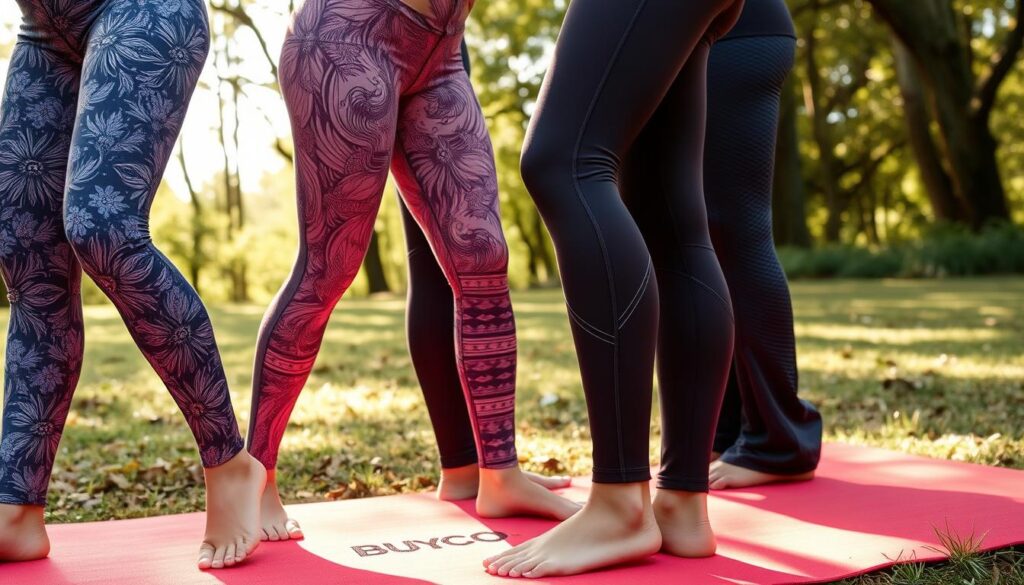

If you love yoga, fitness, or just comfy clothes, knowing about yoga leggings fabrics is key. It helps you choose the best pair for you. Let’s explore the world of yoga leggings fabric and discover the secrets behind these amazing clothes.
Synthetic Fabrics: The Backbone of Yoga Leggings
Synthetic materials are key in performance apparel textiles and stretchy fitness fabrics for yoga leggings. They bring many benefits that fit well with active lifestyles. These athleisure clothing materials are at the heart of the industry.
Fibers like polyester and nylon have changed yoga leggings. They offer great moisture-wicking, breathability, and stretch. These fabrics are made to meet the needs of today’s athletes, ensuring comfort and performance.
- Moisture-wicking properties draw sweat away from the skin, keeping you dry and comfortable.
- Exceptional breathability allows for efficient temperature regulation, preventing overheating.
- Extraordinary stretch and recovery ensure a perfect fit and freedom of movement.
These performance apparel textiles have changed yoga leggings. They are now a must-have in any activewear collection. Whether you’re doing yoga or intense workouts, these stretchy fitness fabrics support you.
Synthetic fabrics have truly transformed the yoga leggings market, offering unparalleled performance and comfort for active individuals.
The need for athleisure clothing materials keeps growing. Synthetic fibers are still crucial in yoga leggings. They have changed the game in style and function.
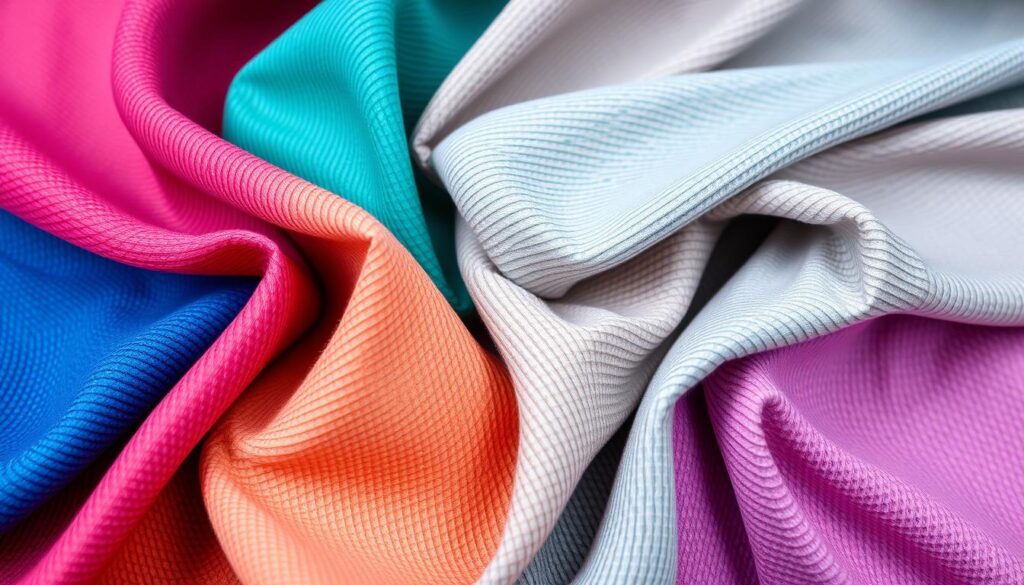

Polyester: A Breathable and Moisture-Wicking Choice
Polyester is a top pick for sweat-wicking yoga pants fabrics. It’s a synthetic fiber known for its ability to keep you dry and cool. This makes it a favorite for breathable activewear fabrics.
The Benefits of Polyester for Activewear
Polyester is great for technical leggings textiles. It’s tough and doesn’t wrinkle, so your leggings look good even after hard workouts. Plus, it dries fast, keeping you comfy and dry.
- Breathable and moisture-wicking properties keep you cool and dry during exercise
- Durable and wrinkle-resistant for a polished, long-lasting look
- Lightweight and flexible, allowing for unrestricted movement
- Easy to care for and maintain, with quick-drying capabilities
Polyester is loved by many for its techy features and comfy fit. It’s perfect for yoga or HIIT workouts. Polyester sweat-wicking yoga pants fabrics help you stay focused and confident.
“Polyester is the backbone of many high-performance activewear fabrics, offering a winning combination of breathability, moisture management, and durability.”
Nylon: Durable and Stretchy for Intense Workouts
In the world of compression tights materials, stretchy fitness fabrics, and technical leggings textiles, nylon stands out. It’s known for its strength, stretch, and durability. This makes it perfect for yoga leggings that can handle tough workouts.
Nylon is great for yoga leggings because it fits well and lets you move freely. It’s strong enough for an active life and stretchy for yoga or fitness. This fabric is a winner for those who love to stay active.
| Nylon Fabric Properties | Benefits for Yoga Leggings |
|---|---|
| Exceptional Strength | Durable construction for high-intensity workouts |
| Excellent Stretch and Flexibility | Unrestricted range of motion during yoga and fitness activities |
| Moisture-Wicking Capability | Keeps the skin dry and comfortable during sweaty sessions |
| Quick-Drying Properties | Allows for easy maintenance and rapid recovery after workouts |
Nylon is a top choice for compression tights materials and stretchy fitness fabrics. It’s strong, stretchy, and wicks away moisture. Whether you’re doing yoga or intense training, nylon yoga leggings offer the support you need to excel.
Spandex: The Secret Ingredient for Stretch and Recovery
Spandex, also known as elastane, is a game-changer in yoga leggings. It’s the secret ingredient that gives the ultimate stretch and recovery. Your leggings will move smoothly with your body, even in tough yoga poses.
Spandex stretches up to five times its length and then snaps back. This makes it key in fabric blends for technical leggings. It ensures a comfy and supportive fit that stays the same, even after lots of wear.
Adding spandex to compression tights and stretchy fabrics boosts flexibility and range of motion. It also keeps the leggings’ shape and structure. This is crucial for yogis who need their clothes to move with them, not hold them back.
“Spandex is the unsung hero of yoga leggings, providing the perfect balance of stretch and recovery for an optimal fit and performance.”
By mixing spandex with fabrics like polyester and nylon, makers create leggings that are both tough and comfy. This lets yogis focus on their practice without worrying about their clothes.
Spandex in your yoga leggings means they’ll move with you, not against you. They support your movements and help you reach your fitness goals, whether you’re doing sun salutations or holding a tough pose.
What Is Yoga Leggings Fabric Called?
Yoga leggings are made from a mix of synthetic and natural fibers. This blend gives them the right mix of performance and comfort. Knowing about these fabrics helps you pick the best yoga pants material or athleisure clothing materials for your active life.
Unraveling the Common Fabric Blends
Polyester and spandex are a top choice for performance apparel textiles like yoga leggings. Polyester keeps you cool and dry. Spandex lets you move freely by adding stretch and recovery.
- Nylon and spandex is another blend that’s durable and fits well.
- Some leggings also use bamboo or organic cotton. These natural fibers are soft and eco-friendly, yet still perform well.
Looking for a yoga pants material that’s comfy, breathable, and stretchy is key. This ensures you can move easily and confidently during your workouts.
“The fabric used in yoga leggings is often a blend of various synthetic and natural fibers, each contributing unique properties to the overall performance and comfort of the garment.”
Natural Fibers: Eco-Friendly Alternatives for Yoga Leggings
More people are looking for sustainable activewear for yoga. Bamboo fabric and organic cotton activewear are top picks. They are soft, breathable, and good for the planet.
Bamboo is a big hit for yoga leggings. It’s soft, wicks moisture, and fights off bacteria. Unlike synthetic fabrics, it’s gentle on your skin. Organic cotton is another great choice. It’s classic, comfy, and fits with yoga’s natural vibe.
| Fabric | Key Features | Sustainability Benefits |
|---|---|---|
| Bamboo fabric | Moisture-wicking, antimicrobial, soft, breathable | Renewable resource, biodegradable, grown without pesticides |
| Organic cotton activewear | Soft, comfortable, durable | Grown without synthetic chemicals, fair trade, biodegradable |
The yoga and fitness world is getting greener. Natural fiber activewear is becoming more popular. Brands that use bamboo fabric and organic cotton activewear are attracting eco-aware shoppers.
Choosing natural fibers for my yoga leggings has been a game-changer. I feel more connected to the earth and my practice, all while enjoying the incredible softness and breathability of these sustainable fabrics.”
Bamboo: Soft, Breathable, and Sustainable
The yoga and athleisure wear world is changing fast. Bamboo fabric is leading the way with its amazing performance and green benefits. It comes from the quick-growing bamboo plant. This fiber is soft, breathable, and strong, making it a top pick for activewear fabrics.
The Advantages of Bamboo Fabric
Bamboo fabric is super breathable. Its natural fibers let air flow freely. This keeps you cool and comfy during tough yoga or workouts.
It’s also very soft and gentle on your skin. Bamboo fabric is hypoallergenic and doesn’t cause irritation. This makes it a great choice for activewear. It’s also stretchy and bounces back, allowing for free movement.
Most importantly, bamboo fabric is eco-friendly. Bamboo grows fast and doesn’t need pesticides or water. This makes it a green option compared to synthetic fabrics. It meets the needs of those who care about the planet.
“Bamboo fabric is a game-changer in the world of activewear. Its unparalleled combination of breathability, softness, and sustainability makes it a must-have for any eco-conscious yogi or fitness enthusiast.”
Organic Cotton: A Classic Choice for Comfortable Activewear
I love organic cotton for my activewear. It’s soft, breathable, and eco-friendly. It’s perfect for those with sensitive skin, making workouts comfortable.
Organic cotton keeps me cool and dry, even during tough workouts. Its natural fibers wick away moisture. This makes it great for yoga leggings, sports bras, and more.
Choosing organic cotton supports sustainable fashion. It’s comfortable and eco-friendly. It’s a great choice for an active lifestyle and a greener future.
FAQ
What is the fabric used in yoga leggings called?
Yoga leggings are made from a mix of synthetic and natural fibers. This blend enhances both performance and comfort. Commonly, you’ll find polyester, nylon, and spandex, along with natural options like bamboo and organic cotton.
What are the benefits of polyester in yoga leggings?
Polyester is a top pick for yoga leggings. It’s great at pulling moisture away and keeping you cool. It’s also durable, dries quickly, and doesn’t wrinkle easily, perfect for workout clothes.
How does nylon contribute to the performance of yoga leggings?
Nylon is another key fabric in yoga leggings. It’s strong, stretchy, and holds up well to tough workouts. This makes nylon ideal for activities that need a snug, secure fit.
What is the role of spandex in yoga leggings?
Spandex, or elastane, is crucial in yoga leggings. It adds the ultimate stretch and bounce back. This lets the leggings fit your body perfectly and stay that way, even after lots of wear.
What are the advantages of using natural fibers like bamboo and organic cotton in yoga leggings?
There’s a growing interest in eco-friendly yoga leggings. Natural fibers like bamboo and organic cotton are softer and more breathable. They’re a cozy, green choice for those who love to stay active.


